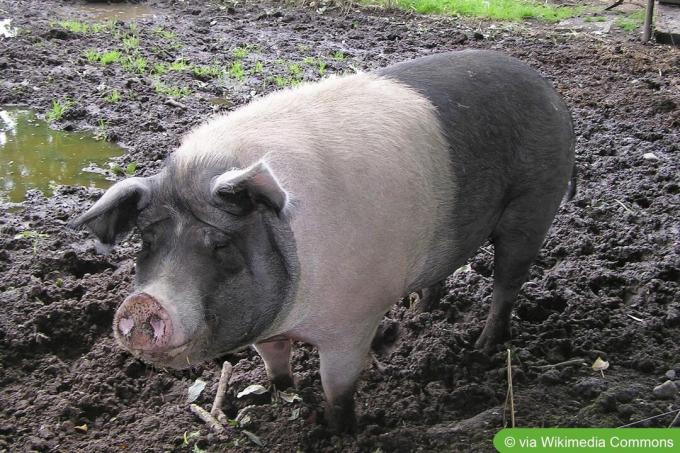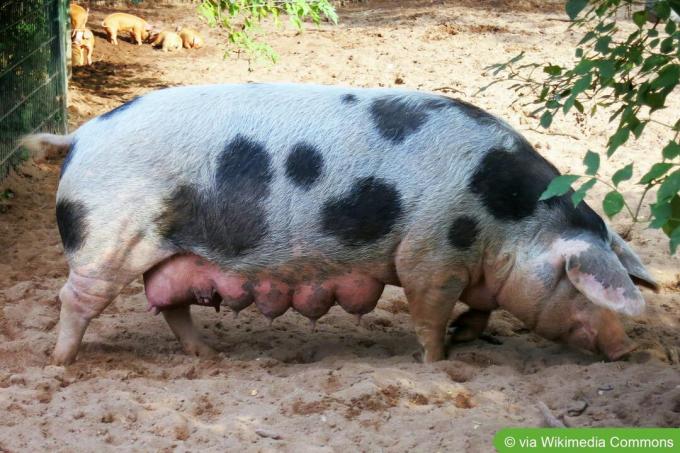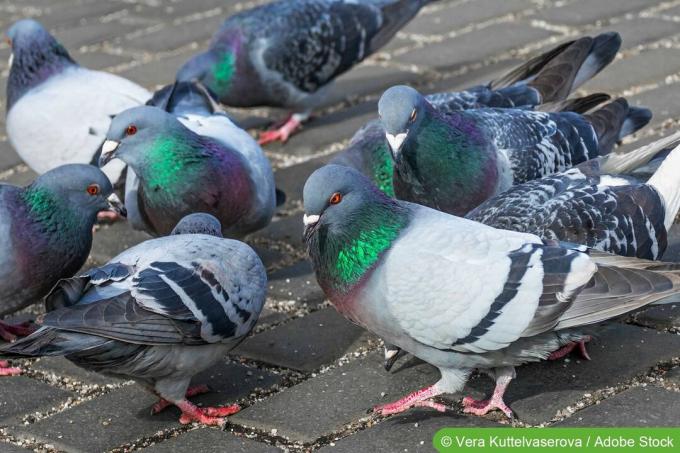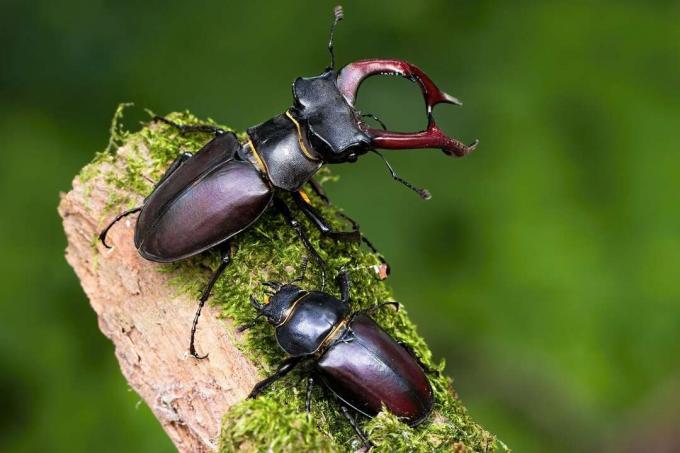

Table of contents
- Pig breeds from A to D
- From G to M
- From P to W
- frequently asked Questions
Pigs are impressive animals. Anyone who sees them only as meat producers is missing out. Find out how interesting and diverse the animals are. We present 15 pig breeds.
Pig breeds from A to D
Angler saddle pig

The angler saddle pig got its name because it looks like it has a white belt or saddle on it. It is black on the head and the back half of the body.
- Weight boar: 350 kilograms
- Weight sow: 300 kg
- Size: 80 to 95 centimeters
- Colour: black with a white centre
- Character: robust, undemanding, free range in winter possible
- Characteristics: lop ears
- Litter size: 11 piglets
- Danger: yes
- Origin: Germany (Schleswig-Holstein)
A notice:
By the way, it used to be common in games that the loser also received a consolation prize. Mostly it was a small piglet. The loser had the chance to make something of his consolation prize. If he fattened the pig, it turned out to be a real win. This is how today's "lucky pig" developed.
Colorful Bentheim country pig

The colorful Bentheimer is one of the best-known old German pig breeds. It is in danger of extinction. Today it is bred again increasingly, because its meat is particularly tasty.
- Weight boar: 250 kilograms
- Weight sow: 180 kg
- Size: 70 to 75 centimeters
- Colour: white with black spots
- Character: robust, easy-care, stress-resistant
- Characteristics: lop ears
- Litter size: 10 piglets
- Danger: yes
- Origin: Germany (Lower Saxony)
German noble pig
The German noble pig is particularly stress-resistant and very fertile.
- Weight boar: 350 kilograms
- Weight sow: 300 kg
- Size: 80 to 85 centimeters
- Colour: white with white bristles
- Character: undemanding, free-range in winter possible
- Characteristics: erect ears, broad head
- Litter size: 14 piglets
- Danger: yes
- Origin: Germany
German landrace
The German landrace emerged at the beginning of the 20th century. century from various German country pig breeds. The animals are suitable for grazing.
- Weight boar: 300 kilograms
- Weight sow: 250 kg
- Size: 80 to 90 centimeters
- Colour: white with white bristles
- Character: undemanding, good maternal qualities
- Characteristics: Drop ears, elongated body
- Litter size: 13 piglets
- Danger: yes
- Origin: Germany
German saddle pig

After World War II, Angler saddle pigs and Swabian Hall pigs became World War I created a new breed in East Germany, the German saddle pig. It convinces with tasty, but quite high-fat meat.
- Weight boar: 350 kilograms
- Weight sow: 300 kg
- Size: 80 to 85 centimeters
- Colour: black with white hull
- Character: robust, undemanding, perfect maternal qualities, good milk production
- Characteristics: lop ears, white areas in the fur of different widths
- Litter size: 11 piglets
- Danger: yes
- Origin: Germany
Duroc

Due to their robustness, Duroc pigs have been incorporated into many new breeds.
- Weight boar: 350 kilograms
- Weight sow: 300 kg
- Size: 80 to 90 centimeters
- Colour: reddish brown, mahogany, yellow
- Character: robust, trusting, not very susceptible to illness, good maternal qualities
- Characteristics: small lop ears
- Litter size: 8 piglets
- Danger: no
- Origin: United States
Tip:
The balance between fat and muscle and the good taste make Duroc meat very popular.
From G to M
Göttingen mini pig

This cute breed of pig was created at the University of Göttingen by crossing a Minnesota Minipig with a pot-bellied pig and a domestic pig. Mini pigs are offered in different colors.
- Weight boar: 55 kilograms
- Weight sow: 40 kg
- Size: 32 to 40 centimeters
- Colour: white, black, brown spotted
- Character: robust, vital, calm, balanced
- Characteristics: erect ears, short trunk
- Litter size: 6 piglets
- Danger: no
- Origin: Germany (Lower Saxony)
Hampshire

Hampshire pigs are unmistakably a saddle pig. Their black fur is broken up by a broad white stripe.
- Weight boar: 320 kilograms
- Weight sow: 280 kg
- Size: 60 to 80 centimeters
- Colour: black with white stripe on the body and white front legs
- Character: curious, active, suitable for free-range husbandry, adult boars easily irritated
- Characteristics: erect ears
- Litter size: 8 piglets
- Danger: no
- Origin: England
A notice:
The Hampshire pig is raised in more than 50 countries around the world. It is one of the most widespread breeds of pigs in the world.
Leicoma
Meat from Leicoma pigs has a special quality due to the high intramuscular fat content. The flavor carrier fat is well intertwined with muscle tissue.
- Weight boar: 250 kilograms
- Weight sow: 180 kg
- Length: 70 to 75 centimeters
- Colour: white to light pink with long bristles
- Character: robust, strong, calm
- Characteristics: lop ears, short legs
- Litter size: 11 piglets
- Endangerment: extremely endangered
- Origin: Germany (Central Germany)
A notice:
The name Leicoma was formed from the first letters of the cities of Leipzig, Cottbus and Magdeburg. This is where the main breeding farms of the breed were located.
Minnesota mini pig
The Minnesota Minipig is a fairly large miniature pig that resembles the common domestic pig.
- Weight boar: 100 kilograms
- Weight sow: 60 kg
- Size: 35 to 40 centimeters
- Color: white, black, brown, black and white
- Character: easy to care for
- Characteristics: erect ears
- Litter size: 6 piglets
- Danger: no
- Origin: United States
From P to W
Pietrain

The Pietrain pig, which comes from Belgium, convinces with a high meat content and the lowest fat content among the pigs kept in Germany.
- Weight boar: 300 kilograms
- Weight sow: 260 kg
- Size: 60 to 80 centimeters
- Colour: white or spotted
- Character: More susceptible to stress than other breeds
- Characteristics: pricked ears, short body, lean meat
- Litter size: 9 piglets
- Danger: no
- Origin: Belgium
Red Husum pig

The red and white Husum pig is one of the larger pig breeds. It is perfectly suited to grazing and can also be left outside in winter.
- Weight boar: 350 kilograms
- Weight sow: 300 kg
- Height: 85 to 92 centimeters
- Colour: reddish brown with white body
- Character: robust, vital, calm, balanced
- Characteristics: Dropped or semi-pricked ears
- Litter size: 11 piglets
- Danger: yes
- Origin: Germany (Schleswig-Holstein)
A notice:
The common term "(Danish) protest pig" probably goes back to the fact that Danish farmers the occupation of Schleswig and Holstein by Prussia and Austria with the red and white animals "flagge showed”.
Turopolje

The Turopolje pig is named after the Croatian region of Turopolje. The breed is often kept in Austria and Switzerland. Its popularity is also increasing in Germany.
- Weight boar: 250 kilograms
- Weight sow: 200 kg
- Size: 80 to 90 centimeters
- Color: white, gray, with round black spots
- Character: robust, cold-resistant
- Characteristics: long hanging ears, small feet, dense bristles
- Litter size: 6 piglets
- Danger: yes
- Origin: Croatia
Vietnamese pot-bellied pig

The pot-bellied pig, which is one of the mini pigs, cannot see well, but has a particularly keen sense of smell.
- Weight boar: 70 kg
- Weight sow: 60 kg
- Size: 40 to 50 centimeters
- Colour: black and white, grey
- Character: calm, trusting
- Characteristics: hanging belly, short legs, wrinkled skin with long bristles
- Litter size: 11 piglets
- Danger: no
- Origin: Vietnam
A notice:
Keeping pot-bellied pigs in gardens or residential areas is prohibited.
wool pig

Due to its high fat content, the population of woolly pigs has declined sharply over many years. Today more people appreciate the high-quality meat and more self-sufficient keep the friendly, uncomplicated breed.
- Weight boar: 160 kilograms
- Weight sow: 180 kg
- Size: 75 to 85 centimeters
- Colour: grey-brown
- Character: robust, easy to care for, uncomplicated
- Characteristics: curly bristles, gray skin, black proboscis, black claws
- Litter size: 5 piglets
- Danger: yes
- Origin: Hungary
A notice:
This breed of pig is also called Mangalica pig or Mangalitza pig.
frequently asked Questions
In principle, anyone can keep pigs privately, no agricultural training is required. However, pigs are farm animals, not pets like cats and dogs. Pig farming is therefore prohibited in residential areas. Keeping pigs in the garden in rural areas as well as in industrial and mixed areas is permitted.
An area of 500 square meters should be available per pig. For mini pigs, 100 square meters are considered sufficient. In addition, legal provisions must be observed. For example, pigs must be registered with the Animal Disease Fund. You can get all the information about the regulations to be observed from the veterinary office in your district. Get advice there before you buy pigs.
Yes, according to EU law Pigs kept privately must also be marked with an ear tag.
Pigs usually eat ground grain, hay and straw, boiled potatoes, fruits and vegetables as well acorns, tree bark, leaves and grass. Pigs that have plenty of space to roam and exercise well consume more feed than livestock only. Pigs do not tolerate meat, fish or sweets.
 Mirko
Mirko
Learn more about animals

Killing pigeons with baking soda: what the law says
Is it allowed to kill pigeons with baking powder and is this home remedy even suitable? The German legislator takes a clear position on this. Find out in the guide what there is to know about it and what the legal basis looks like.

Killing pigeons with vinegar: what's the deal?
Pigeons in the garden and on the balcony can be a big nuisance. There are a variety of home remedies you can use to get rid of it. In this article, we explore the question of whether there is any truth to the claim that pigeons can be killed with vinegar.

Identify beetles with pincers: 10 native species
Beetles are impressive insects. There are large and small, dark and dazzlingly colorful species. Some have pincer-like upper jaws for crushing or holding prey. The stag beetle is the largest among them. We present 10 native beetles with pincers.

Mice species in Germany: 20 native mice
In Germany, not only field mice and house mice are native, but also some other species that you often don't see at all or only very rarely. Here we present 20 native mouse species.

Insect Hotel Filling: 10 filling materials
An insect hotel in your own garden offers numerous insects artificial shelter, nesting and wintering opportunities. They are more than necessary, because they are disappearing more and more as a result of massive human intervention in nature. They are essential for survival.

What do ladybugs eat and drink?
There isn't just one ladybug. Instead, there are several different species, not all of which eat aphids in the classic way. Some are even pure herbivores. Read here what else ladybugs like as food.



